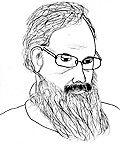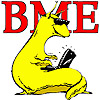
|
| SoE home |

|
| Kevin Karplus's home page |

|
| Biomolecular Engineering Department |
Kevin Karplus taught at Cornell University for four years before joining the UCSC faculty. At UCSC, his research interests changed from VLSI CAD tools to bioinformatics. Work as part of the UCSC bioinformatics group includes protein-structure prediction, evaluating methods for estimating distributions of amino acids given just a few instances from the distribution, and design of a SIMD parallel computer that is particularly good for sequence alignment and linear HMM training ( Kestrel ).
Since 1993 he has worked in bioinformatics---analyzing the vast databases created by high-throughput biological experimentation, such as the human genome project. He has used several techniques from machine learning and Bayesian statistics, including hidden Markov models (HMMs), mixtures of Dirichlet priors, and neural networks.
Most recently, he has concentrated on automatic techniques for finding remotely related proteins using sequence information to build HMMs. These techniques have been applied to protein structure prediction, and he lead teams participating in the Critical Assessment of Structure Prediction experiments ( CASP2 1996, CASP3 1998, and CASP4 2000). The group did quite well in these blind prediction experiments in all three attempts (in the top 6 groups worldwide for fold recognition), and hope to continue to do well this year.
The group lead by Karplus has also built secondary structure predictors, using the multiple alignments created for the HMM search, neural networks, and some new techniques using HMMs for secondary structure prediction. An early version of this secondary structure predictor was one of the best two in 1998 (CASP3) and continues to be in the best group in the EVA evaluation. (It also did quite well at CASP4, but that evaluation was over too small a set of proteins to distinguish between the good predictors.)
The group has installed a web server providing free access to our methods ( http://www.soe.ucsc.edu/research/compbio/HMM-apps), and have licensed the HMM software to many research groups (free to academics, governments, and non-profits, with a moderate fee to industry).
Prof. Karplus and his students are currently working on different approaches to protein structure prediction, including some different secondary-structure prediction techniques using HMMs and a fragment-packing approach that combines homology modeling, fold recognition, and ab initio prediction into a single framework. The fragment-packing method is similar in concept, though not in detail, to the highly successful methods of David Baker's group at University of Washington.
Here is a selection of papers (not frequently updated)---see http://www.soe.ucsc.edu/research/compbio/research.html for a better-maintained list of research in the bioinformatics group:
Earlier work includes the "Digitar" algorithm for producing plucked-string sounds with very little computation (joint patent with Alex Strong), the ITEM (if-then-else minimizer) for multi-level logic minimization, a systolic decoder for the 73-bit perfect difference code, early work on the DELTA system for writing text-to-speech synthesis rules, work on the ROPE parallel architecture, and early work on river-routing for VLSI.
Here are some old tech reports:
|
|
|
UCSC Bioinformatics research |
Questions about page content should be directed to
Kevin Karplus
Biomolecular Engineering
University of California, Santa Cruz
Santa Cruz, CA 95064
USA
karplus@soe.ucsc.edu
1-831-459-4250
318 Physical Sciences Building